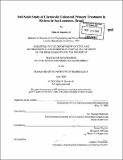| dc.contributor.advisor | Donald Harleman and Susan Murcott. | en_US |
| dc.contributor.author | Bourke, Mike R. (Mike Robert), 1976- | en_US |
| dc.contributor.other | Massachusetts Institute of Technology. Dept. of Civil and Environmental Engineering. | en_US |
| dc.coverage.spatial | s-bl--- | en_US |
| dc.date.accessioned | 2005-09-27T19:36:52Z | |
| dc.date.available | 2005-09-27T19:36:52Z | |
| dc.date.copyright | 2000 | en_US |
| dc.date.issued | 2000 | en_US |
| dc.identifier.uri | http://hdl.handle.net/1721.1/8975 | |
| dc.description | Thesis (M.Eng.)--Massachusetts Institute of Technology, Dept. of Civil and Environmental Engineering, 2000. | en_US |
| dc.description | Includes bibliographical references (leaves 148-149). | en_US |
| dc.description.abstract | Effective, low-cost wastewater treatment that permits removal of pollutants and the deactivation of pathogens is essential to protect public health. An emerging technology that has been proposed to accomplish this goal, is Chemically Enhanced Primary Treatment, or CEPT. CEPT vastly improves the effectiveness of an existing wastewater treatment facility, enabling the plant to not only meet increasing flow demands, but to attain higher removal efficiencies at the same time. Similarly, in the case of a new treatment facility, it can be designed to treat larger amounts of flow, and/or the designed size can be decreased by as much as half, and still meet expected capacity. The governing principle behind CEPT is the enhancement of the primary settling process through the addition of low dosages of metal salts and extremely small amounts of an anionic polymer. These additions cause the particulate matter in the wastewater to coagulate and flocculate, thus creating larger particles, which in turn settle at a much faster rate. This thesis looks at the different forms by which CEPT can be implemented in wastewater lagoon systems, namely "pre-pond" and "in-pond" CEPT. While there is discussion of numerous CEPT plants, special attention is paid to the full-scale study and analysis of the CEPT upgrade at Riviera de Sao Lourenco, Brazil. This plant conducted full-scale tests of both "prepond" and "in-pond" CEPT. This thesis compares the advantages and disadvantages of "prepond" and "in-pond" CEPT, along with the effectiveness of each. | en_US |
| dc.description.statementofresponsibility | by Mike R. Bourke, Jr. | en_US |
| dc.format.extent | 149 leaves | en_US |
| dc.format.extent | 13306112 bytes | |
| dc.format.extent | 13305866 bytes | |
| dc.format.mimetype | application/pdf | |
| dc.format.mimetype | application/pdf | |
| dc.language.iso | eng | en_US |
| dc.publisher | Massachusetts Institute of Technology | en_US |
| dc.rights | M.I.T. theses are protected by copyright. They may be viewed from this source for any purpose, but reproduction or distribution in any format is prohibited without written permission. See provided URL for inquiries about permission. | en_US |
| dc.rights.uri | http://dspace.mit.edu/handle/1721.1/7582 | |
| dc.subject | Civil and Environmental Engineering. | en_US |
| dc.title | Full scale study of chemically enhanced primary treatment in Riviera de Sao Lourenco, Brazil | en_US |
| dc.type | Thesis | en_US |
| dc.description.degree | M.Eng. | en_US |
| dc.contributor.department | Massachusetts Institute of Technology. Department of Civil and Environmental Engineering | |
| dc.identifier.oclc | 47089674 | en_US |
